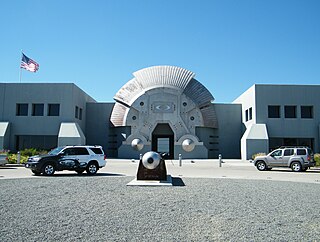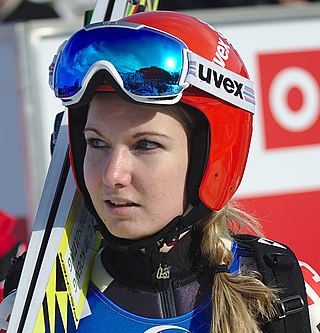
Snowboarding is a recreational and competitive activity that involves descending a snow-covered surface while standing on a snowboard that is almost always attached to a rider's feet. It features in the Winter Olympic Games and Winter Paralympic Games.

To improve motorcycle safety, many countries mandate the wearing of personal protective equipment such as protective clothing and helmets. Protective clothing may include certain types of jackets, gloves, boots, and pants. Jackets meant for motorcyclists are typically made of leather or specialized man-made fabrics like cordura or Kevlar. These jackets typically include padding on the elbow, spine, and shoulder regions. This was once quite bulky, but modern technology and materials have made it unobtrusive. Gloves are generally made of leather or Kevlar and some include carbon fiber knuckle protection. Boots, especially those for sport riding, include reinforcement and plastic caps on the ankle and toe areas. Pants are usually leather, cordura, or Kevlar. Except for helmets, none of these items are required by law in any state in the USA, or in any part of the UK but are recommended by many of those who ride.

Sunglasses or sun glasses are a form of protective eyewear designed primarily to prevent bright sunlight and high-energy visible light from damaging or discomforting the eyes. They can sometimes also function as a visual aid, as variously termed spectacles or glasses exist, featuring lenses that are colored, polarized or darkened. In the early 20th century, they were also known as sun cheaters.
Photokeratitis or ultraviolet keratitis is a painful eye condition caused by exposure of insufficiently protected eyes to the ultraviolet (UV) rays from either natural or artificial sources. Photokeratitis is akin to a sunburn of the cornea and conjunctiva.

Oakley, Inc. is an American company headquartered in Foothill Ranch, California, which is an autonomous subsidiary of Luxottica. The company designs, develops and manufactures sports performance equipment and lifestyle pieces including sunglasses, safety glasses, eyeglasses, sports visors, ski/snowboard goggles, watches, apparel, backpacks, shoes, optical frames, and other accessories. Most items are designed in house at their head office, but some countries hold exclusive designs relevant to their market. Oakley currently holds more than 600 patents for eyewear, materials, and performance gear.

Goggles, or safety glasses, are forms of protective eyewear that usually enclose or protect the area surrounding the eye in order to prevent particulates, water or chemicals from striking the eyes. They are used in chemistry laboratories and in woodworking. They are often used in snow sports as well, and in the sport of swimming. Goggles are often worn when using power tools such as drills or chainsaws to prevent flying particles from damaging the eyes. Many types of goggles are available as prescription goggles for those with vision problems.
Atomic Austria GmbH is an Austrian sports equipment company headquartered in Salzburg, Austria. It manufactures and sells skis and other skiing equipment, such as boots, bindings, helmets, ski poles, goggles, bags, apparel and protective equipment. Atomic is a subsidiary of Finnish retail conglomerate Amer Sports, which in turn, oversees Arc'teryx, Precor, Salomon, Suunto, Sports Tracker, and Wilson.

Mirrored sunglasses are sunglasses with a reflective optical coating on the outside of the lenses to make them appear like small mirrors. The lenses typically give the wearer's vision a brown or grey tint. The mirror coating decreases the amount of light passing through the tinted lens by a further 10–60%, making it especially useful for conditions of sand, water, snow, and higher altitudes. Mirrored sunglasses are one-way mirrors.
Burton Snowboards is a privately-owned snowboard manufacturing company that was founded by Jake Burton Carpenter in 1977. The company specializes in products aimed at snowboarders, such as snowboards, bindings, boots, outerwear, and accessories. The company, whose flagship store is in Burlington, Vermont, was privately owned by Jake Burton Carpenter, until his death in 2019, and by his wife, Donna Carpenter, who has been active in the business since 1983.

Theodore Sharp Ligety is a retired American alpine ski racer, a two-time Olympic gold medalist, and an entrepreneur, having cofounded Shred Optics. Ligety won the combined event at the 2006 Olympics in Turin and the giant slalom race at the 2014 Olympics in Sochi. He is also a five-time World Cup champion in giant slalom. Ligety won the gold medal in the giant slalom at the 2011 World Championships. He successfully defended his world title in giant slalom in 2013 in Schladming, Austria, where he also won an unexpected gold medal in the super-G and a third gold medal in the super combined.

D3O is the namesake ingredient brand of British company D3O Lab, specializing in rate-sensitive impact protection technologies.
Shaun Palmer is an American professional snowboarder, skier, mountain biker, and motocross rider. Nicknamed "Napalm" and "Palm Daddy", he is known as one of the forefathers of extreme sports. He won the Laureus World Action Sportsperson of the Year in 2000.

Aviator sunglasses are a style of sunglasses that was developed by a group of American firms. The original Bausch & Lomb design is now commercially marketed as Ray-Ban Aviators, although other manufacturers also produce aviator-style sunglasses.

A ski helmet is a helmet specifically designed and constructed for winter sports. Use was rare until about 2000, but by about 2010 the majority of skiers and snowboarders in the US and Europe wore helmets. Helmets are available in many styles and typically consist of a hard plastic/resin shell with inner padding. Modern ski helmets may include many additional features, such as vents, earmuffs, headphones, goggle mounts, and camera mounts.
Shredding, shred, shredder, or shredders may refer to:
Head Sport GmbH is an American-Austrian manufacturing company headquartered in Kennelbach. It owns the American tennis racket brand Head. Head GmbH is a group that includes several previously independent companies, including the original "Head Ski Company" ; Tyrolia, an Austrian ski-equipment manufacturer; and Mares, an Italian manufacturer of diving equipment.
Swans is the brandname of the Japanese eyewear manufacturer Yamamoto Kogaku Co., Ltd. located in Osaka, Japan. The company produces and sells optical lenses, sunglasses, goggles, as well as safety glasses. The sports eyewear brand Swans includes sunglasses, ski and snowboard goggles, swimming goggles, as well as helmets.
Zoggs is a brand of swimming goggles, training aids, swimwear and other related products. The company launched in Sydney, Australia in 1992 and was the first brand to offer UV protection and split yoke straps as standard features on all goggles.
Ballistic eyewear is a form of glasses or goggles that protect from small projectiles and fragments. For the U.S. military, choices are listed on the Authorized Protective Eyewear List (APEL). Ballistic eyewear including examples that meet APEL requirements are commercially available for anyone who wishes to buy it. The history of protective eyewear goes back to 1880 and extends through to World War I and the present. There are three standards that are currently used to test the effectiveness of ballistic eyewear. These include a U.S. civilian standard, a U.S. military standard (MIL-PRF-31013), and a European standard.
Tom Wallisch is a professional freeskier.














